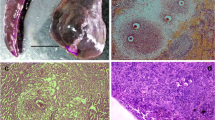Abstract
C57L/J male mice were infected subcutaneously in their left flank with 10 cysts ofEchinococcus multilocularis. The dimensions and histologic features of the larval cyst mass (LCM) were determined at three days, at weekly intervals for 12 weeks, and at 22 weeks postinfection. The LCM doubled its size between 3 and 12 weeks, and at 22 weeks it was five times larger than at three weeks. During the proliferative phase, the LCM was infiltrated massively by neutrophils, macrophages, and progenitors of the plasma cell series. The first two cell types were found firmly bound to the laminated layer of both intact and degenerating cysts, whereas plasma cells colonized the fibrohistiocytic corona and the interlacunar stroma harboring individual cysts. By 22 weeks, the proliferation of the cysts had ceased and histologically the LCM consisted of fibrous and fibrohistiocytic stroma, thick-walled fertile and sterile brood capsules, and predominantly plasmacytic and histiocytic infiltrates. In addition to exogenous budding evidence has been presented also suggesting the role of free germinal cells in the histogenesis of LCM. Regulation of cyst proliferation in susceptible hosts is discussed with reference to antibody-dependent cell mediated cytotoxicity with nonlymphoid inflammatory cells.
Similar content being viewed by others
References
Ali-Khan, Z.: Host-parasite relationship in echinococcosis. I. Parasite biomass and antibody response in three strains of inbred mice against graded doses ofEchinococcus multilocularis cysts. J. Parasitol.60, 231–235 (1974a)
Ali-Khan, Z.: Host-parasite relationship in echinococcosis. II. Cyst weight, hematologic alterations and gross changes in the spleen and lymph nodes of C57L mice against graded doses ofEchinococcus multilocularis cysts. J. Parasitol.60, 235–242 (1974b)
Ali-Khan, Z.: Cellular changes in the lymphoreticular tissues of C57L/J mice infected withEchinococcus multilocularis cysts. Immunology34, 831–839 (1978a)
Ali-Khan, Z.: Pathological changes in the lymphoreticular tissues of Swiss mice infected withEchinococcus granulosus cysts. Z. Parasitenkd.58, 47–54 (1978b)
Ali-Khan, Z.:Echinococcus multilocularis: Cell mediated immune response in early and chronic alveolar murine hydatidosis. Exp. Parasitol.46, 157–165 (1978c)
Ali-Khan, Z.: Humoral response to sheep red blood cells in C57L/J mice during early and chronic stages of infection withEchinococcus multilocularis cysts. Z. Parasitenkd.59, 259–265 (1979)
Ali-Khan, Z., Siboo, R.: Persistence of host immunoglobulins on the membranes of freshly isolated and in vitro cultured cysts ofEchinococcus multilocularis cysts. Exp. Parasitol. (1980)
Ali-Khan, Z., Siboo, R.: Pathogenesis and host response in subcutaneous alveolar hydatidosis. II. Intense plasmacellular infiltration in the paracortex of draining lymph nodes. Z. Parasitenkd.62, 255–265 (1980)
Baron, R.W., Tanner, C.E.:Echinococcus multilocularis in the mouse: The in vitro protoscolicidal activity of peritoneal macrophages. Int. J. Parasitol.7, 489–495 (1977)
Butterworth, A.E.: The eosinophil and its role in immunity to helminth infection. Curr. Top. Microbiol. Immunol.77, 127–167 (1977)
Dixon, J.B., Jenkins, P., Allan, D.: Plastic stimulation of unprimed mouse lymphocytes by living protoscolices ofEchinococcus granulosus: a possible connection with transplant immunity. J. Parasitol.61, 949–950 (1978)
Gale, R.P., Zighelboim, J.: Polymorphonuclear leukocytes in antibody-dependent cellular cytotoxicity. J. Immunol.114, 1047–1051 (1975)
Hinz, E.: Befall mitEchinococcus multilocularis und Antikörpertiter bei intraperitoneal und subkutan infizierten NMRI-Mäusen. Tropenmed. Parasitol.24, 198–206 (1973)
Kassis, A.I., Tanner, C.E.: Host serum proteins inEchinococcus multilocularis: complement activation via the classical pathway. Immunology33, 1–9 (1977)
Lubinsky, G.: Growth of the vegetatively propagated strain of larvalEchinococcus multilocularis in some strains of Jackson mice and in their hybrids. Can. J. Zool.42, 1099–1103 (1964)
Mankau, S.K.: Studies onEchinococcus alveolaris (Klemm, 1883), from St. Lawrence Island, Alaska. I. Histogenesis of the alveolar cyst in white mice. J. Parasitol.42, 156–159 (1956)
Morseth, D.J., Soulsby, E.J.L.: Fine structure of leukocytes adhering to the cuticle ofAscaris suum larvae. II. Polymorphonuclear leukocytes. J. Parasitol.55, 1025–1034 (1969)
Ohbayashi, M., Rausch, R.L., Fay, F.H.: On the ecology and distribution ofEchinococcus spp. (Cestoda: Taeniidae), and characteristics of their development with the intermediate host. II. Comparative studies of the development of larvalE. multilocularis. Leuckart, 1863, in the intermediate host. Jap. J. Vet. Res.19, Suppl. 1–53 (1971)
Pollack, S.B., Emmons, S.L., Herrick, M.V.: Inhibition by autologous lymphoid cells of antibody-dependent cellular cytotoxicity (ADCC) to a tumor target. Cell. Immunol.49, 250–259 (1980)
Rausch, R.L.: Studies on helminth fauna of Alaska. XX. The histogenesis of the alveolar larva ofEchinococcus species. J Infect. Dis.94, 178–186 (1954)
Rausch, R.L., Schiller, E.L.: Studies on the helminth fauna of Alaska XXV. The ecology and public health significance ofEchinococcus sibiricensis. Rausch and Schiller 1954, on St. Lawrence Island. Parasitology46, 395–419 (1956)
Svilenov, D., Heymer, B., Haferkamp, O.: Immunomorphology and pathogenesis of Echinococcus. III. Microscopic immunofluorescence studies in experimental alveolar echinococcosis. Infection6, 12–15 (1978)
Tanaka, J., Baba, T., Torisu, M.:Ascaris and eosinophil. II. Isolation and characterization of eosinophil chemotactic factor and neutrophil chemotactic factor of parasite inAscaris antigen. J. Immunol.122, 302–308 (1979)
Vogel, H.: Über denEchinococcus multilocularis Süddeutschlands. II. Entwicklung der Larvenstadien und histopathologische Reaktionen in der Feldmaus,Microtus arvalis. Tropenmed. Parasitol.28, 409–427 (1977)
Vogel, H.: Wie wachst der Alveolarechinokokkus? Tropenmed. Parasitol.29, 1–11 (1978)
Weinberg, T.:Echinococcus alveolaris infection of the human liver. Mt. Sinai J. Med. NY13, 331–336 (1947)
Weiss, N., Tanner, M.: Studies onDipetalonema vitae (Filarioidea). 3. Antibody-dependent cell-mediated destruction of microfilariae in vivo. Tropenmed. Parasitol.30, 73–80 (1979)
West, J.T., Hillman, F.J., Rausch, R.L.: Alveolar hydatid disease of the liver: rationale and technics of surgical treatment. Ann. Surg.157, 548–559 (1963)
Yamashita, J., Ohbayashi, M., Kitamura, Y., Suzuki, K., Okugi, M.: Studies onEchinococcosis. VIII. ExperimentalEchinococcosis multilocularis in various rodents; especially on the difference of susceptibility among uniform strains of the mouse. Jap. J. Vet. Res.,6, 135–155 (1958)
Author information
Authors and Affiliations
Additional information
This work was supported by a grant (MA-7023) from the Medical Research Council of Canada
Rights and permissions
About this article
Cite this article
Ali-Khan, Z., Siboo, R. Pathogenesis and host response in subcutaneous alveolar hydatidosis. Z. Parasitenkd. 62, 241–254 (1980). https://doi.org/10.1007/BF00926565
Received:
Issue Date:
DOI: https://doi.org/10.1007/BF00926565




